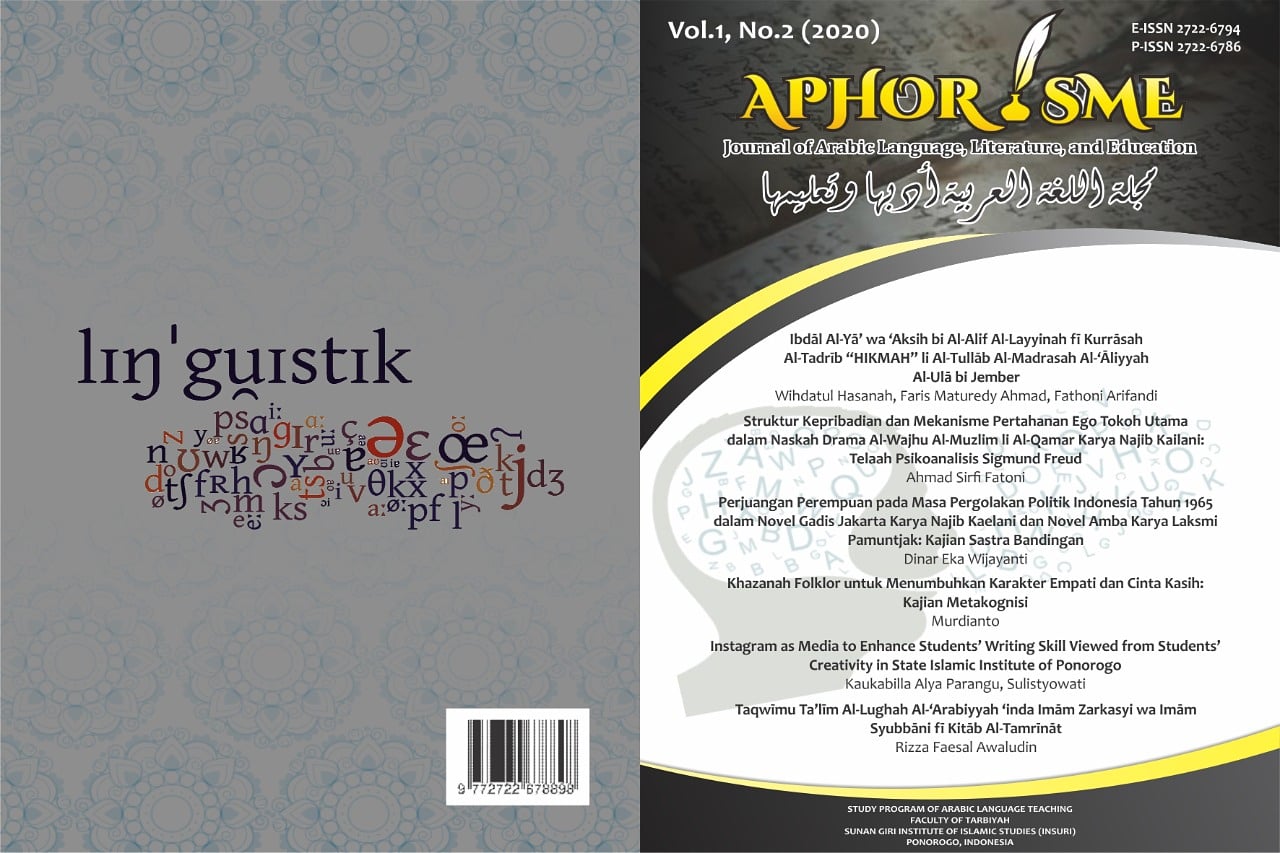Problematika Implementasi Pendekatan Saintifik dalam Pembelajaran Bahasa Arab di Madrasah Aliyah Hidayatul Mubtadiin Magetan
DOI:
https://doi.org/10.37680/aphorisme.v1i2.447Keywords:
Problem, Scientific Approach, Arabic LearningAbstract
The use of a scientific approach in learning Arabic aims to make students active, productive, critical, and analytical thinking in constructing concepts of knowledge and skills in Arabic. This study aims to describe the various problems faced by teachers and students in applying a scientific approach to learning Arabic in the Madrasah Aliyah Hidayatul Mubtadiin Magetan. The method used in this study is a qualitative method with a descriptive approach. Research data were obtained by interview, observation, and documentation. The data found were analyzed and interpreted using the Miles model, which is data reduction, data presentation, and concluding. The results of this study is that the problems of implementing a scientific approach to learning Arabic in the Madrasah Aliyah Hidayatul Mubtadiin Magetan relating to teachers are 1). Irrelevance of Arabic learning methods used by teachers with a philosophical scientific approach, and. 2) Lack of teacher initiative and innovation in encouraging students to be active, productive, think critically, and analytically in learning Arabic. The problems related to students are 1) The tendency of students to build their understanding of Arabic instantly, 2) Lack of encouragement in students to explore material that has been previously studied as a basis for contracting concepts in new material to be learned, and 3) Students' ignorance of the learning objectives being carried out. Mean while the problems related to teaching media are 1) The unpreparedness of teaching media used by teachers or students in supporting the learning process, and 2) Teacher and student inequality in empowering instructional media and those that are already available.
References
Asnawir dan M. Basyiruddin Usman. 2002. Media Pembelajaran. Jakarta: Ciputat Pers.
Aziz Fakhrurrozi dan Erta Mahyudin. 2012. Pembelajaran Bahasa Arab. Direktorat Jenderal Pendidikan Islam
Daryanto. 2014. Pendekatan Pembelajaran Saintifik 2013. Yogyakarta: Gava Media.
Effendy, A. Fuad. 2003. Metodologi Pengajaran Bahasa Arab. Malang: Misykat.
Hamid, M. Abdul. 2018. Pembelajaran Bahasa Arab Pendekatan, Metode, Strategi, Materi dan Media. Malang: UIN Malang Press.
Hosnan, M. 2014. Pendekatan Saintifik dan Kontekstual dalam Pembelajaran Abad 21. Bogor: Ghalia Indonesia,
Majid, Abdul. 2014. Strategi Pembelajaran. Bandung: Remaja Rosdakarya.
Muna,Wa. 2011.Metodologi Pembelajaran Bahasa Arab Teori dan Aplikasi. Yogyakarta: Teras.
Roqib, Moh. 2009. Ilmu Pendidikan Islam. Yogyakarta: LkiS Yogyakarta.
Sani, Ridwan Abdullah. 2015. Pembelajaran Saintifik untuk Implementasi Kurikulum 2013. Jakarta: Bumi Aksara.
Wibowo dan Hamrin, Agus. 2012. Menjadi Guru Berkarakter. Yogyakarta: Pustaka Pelajar.
Downloads
Published
Issue
Section
License
Authors who publish with this journal agree to the following terms:
Authors retain copyright and grant the journal right of first publication with the work simultaneously licensed under a Creative Commons Attribution-NonCommercial 4.0 International License that allows others to share the work with an acknowledgement of the work's authorship and initial publication in this journal.
Authors are able to enter into separate, additional contractual arrangements for the non-exclusive distribution of the journal's published version of the work (e.g., post it to an institutional repository or publish it in a book), with an acknowledgement of its initial publication in this journal.
Authors are permitted and encouraged to post their work online (e.g., in institutional repositories or on their website) prior to and during the submission process, as it can lead to productive exchanges, as well as earlier and greater citation of published work.





.jpg)


1.jpg)
